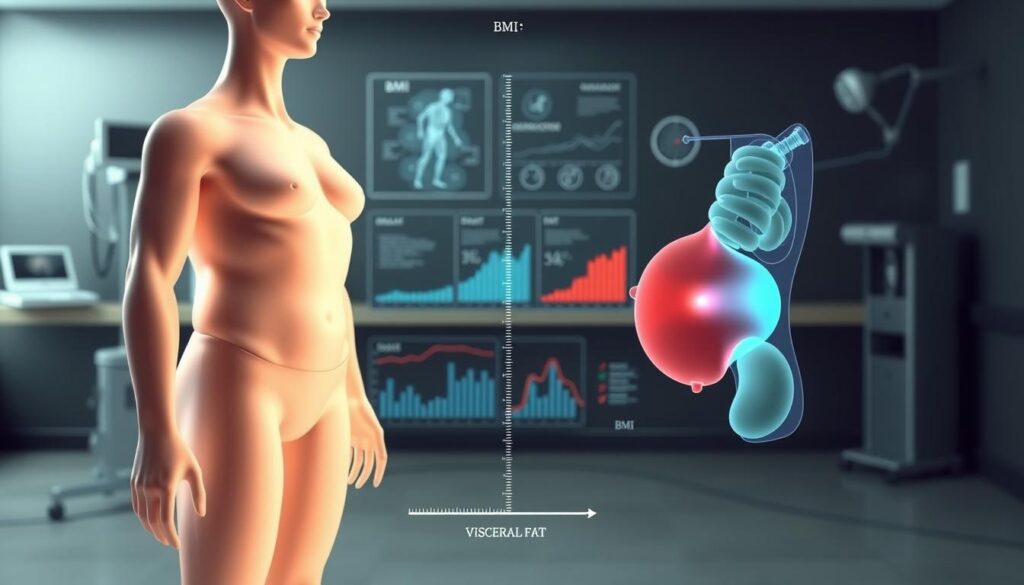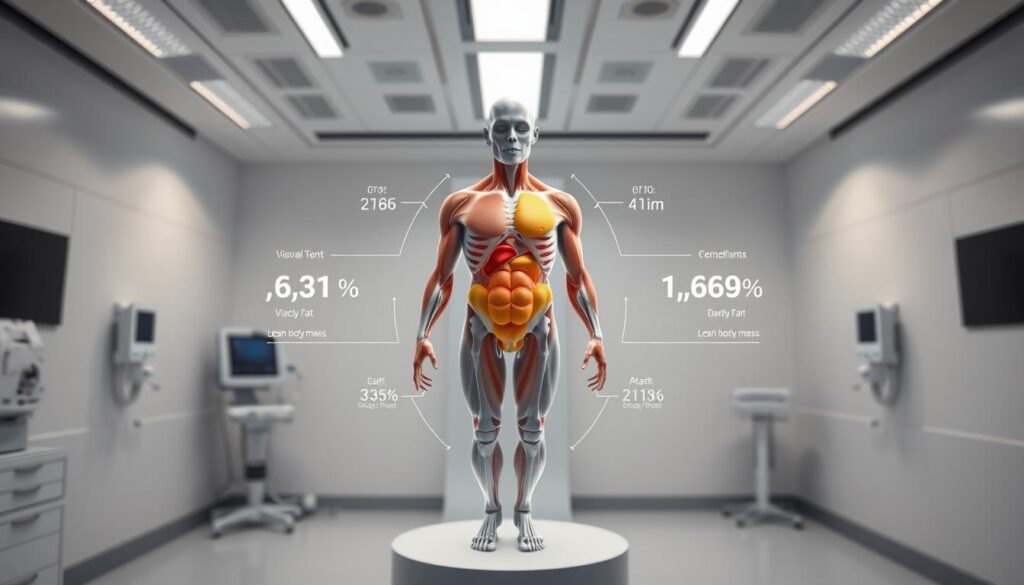Are we too focused on just one way to check our health? For years, Body Mass Index (BMI) has been the main tool for checking obesity and health risks. But, new studies say visceral fat percentage might be a better sign of health risks. The Cleveland Clinic says visceral fat is a bigger health risk than subcutaneous fat.
This makes us wonder: Is BMI enough to judge our health, or should we look at visceral fat percentage too?
Studies show both BMI and visceral fat percentage are linked to health risks like insulin resistance. A study with healthy young adults found that BMI and visceral fat were closely related to insulin resistance. This shows how vital it is to know and compare these metrics.
Key Takeaways
- Understanding the difference between BMI and visceral fat percentage is crucial for assessing health risks.
- Visceral fat is considered a more significant health risk than subcutaneous fat.
- Both BMI and visceral fat percentage correlate with health risks like insulin resistance.
- Using a combination of health metrics may provide a more accurate assessment of health.
- Relying solely on BMI might not be sufficient for evaluating obesity and related health issues.
Understanding BMI: A Fundamental Measurement
BMI, or Body Mass Index, is a key tool in health checks. It helps sort people into weight groups like underweight, normal, overweight, and obese.
Definition of BMI
Body Mass Index (BMI) measures body weight against height. It uses weight and height to show if a person’s weight is healthy.
How BMI is Calculated
BMI uses the Quetelet formula. It divides a person’s weight in kilograms by their height in meters squared (kg/m2). This gives a number that shows their weight status.
For instance, a 70 kg person who is 1.75 meters tall has a BMI of about 22.9. This is found by dividing 70 by (1.75)2.
Limitations of BMI
Even though BMI is helpful, it has limitations. It can’t tell the difference between muscle and fat. This can lead to wrong classifications, like for athletes or those who are very muscular.
Also, BMI doesn’t look at how fat is spread in the body. This is important for understanding health risks related to weight.
Exploring Visceral Fat Percentage
The amount of visceral fat in our bodies shows how well our metabolism is working. Visceral fat wraps around our internal organs like the liver and stomach. It’s different from the fat under our skin because it’s more active and risky for our health.
What is Visceral Fat?
Visceral fat is fat stored inside our belly, close to important organs. Too much of it can cause inflammation and raise the risk of serious health problems. These include heart disease and metabolic syndrome.
Measuring Visceral Fat Percentage
To find out how much visceral fat we have, we use special tests. Dual-Energy X-ray Absorptiometry (DEXA), Computed Tomography (CT) scans, and Magnetic Resonance Imaging (MRI) are some of these. They give us precise numbers, helping doctors understand our health risks.
Health Risks Associated with High Visceral Fat
Having too much visceral fat is linked to serious health issues. Heart diseases and metabolic syndrome are big concerns. Metabolic syndrome is a group of conditions that raise the risk of diabetes and heart disease.
It includes high blood pressure, high blood sugar, belly fat, and bad cholesterol levels. Visceral fat can also make our blood sugar levels go up and our blood pressure rise. This increases the chance of heart disease.
Comparing BMI and Visceral Fat Percentage
BMI and visceral fat percentage are two ways to check body composition and health risks. BMI shows if your weight is healthy for your height. Visceral fat percentage looks at fat around your belly organs.
It’s key to know how these measures differ for a full health check. Let’s look at each one and what it means for your health.
Key Differences Between BMI and Visceral Fat
The main difference is what each measures. BMI uses height and weight to categorize your weight status. Visceral fat percentage focuses on belly fat, which is linked to health issues.
| Metric | BMI | Visceral Fat Percentage |
|---|---|---|
| Measurement Basis | Height and Weight | Fat around abdominal organs |
| Health Risk Indication | General health risk | Specific risk for conditions like diabetes, heart disease |
Advantages of Using Visceral Fat Percentage
Research shows visceral fat is a better health risk indicator than BMI. Visceral fat percentage offers a detailed look at health risks, like metabolic syndrome and heart disease.
One big plus of using visceral fat percentage is it shows different fat distribution patterns. For example, two people with the same BMI can have different belly fat levels, leading to different health risks.
Healthcare experts can better understand health risks by looking at both BMI and visceral fat percentage. This approach helps tailor health advice and treatments.
The Role of Body Composition
Looking at body composition gives us important insights into our health. It shows us how body fat is spread out. This is key to understanding our health risks.
Importance of Body Fat Distribution
Where fat is stored in our bodies matters a lot for our health. Visceral fat, which is fat around vital organs, is very risky. Studies have found that too much visceral fat can lead to serious health problems like metabolic syndrome and heart disease.
It’s not just about how much fat we have. It’s also about where it is and how it impacts our health. Android obesity, which is fat around the belly, is more dangerous than gynoid obesity, which is fat around the hips and thighs.
How Body Composition Affects Health
Body composition analysis is key to spotting health risks. Doctors can use it to find people at risk of metabolic problems. Metabolic health signs, like how well our bodies use insulin and our blood lipid levels, are tied to body composition.
Body composition also affects our mental health. People with a healthy body composition often have better mental health. They tend to have fewer symptoms of anxiety and depression.
- Body composition analysis helps in identifying health risks early.
- Fat distribution assessment informs targeted interventions.
- Metabolic health indicators are closely linked to body composition.
Practical Applications: When to Use Each Metric
It’s important to know when to use BMI and visceral fat percentage for health checks. Each has its own role and fits different situations.
Using BMI for General Population Assessment
BMI is a simple tool for first health checks. It’s great for general population assessments because it categorizes people easily.
In public health, BMI helps spot weight issues quickly and cheaply. It guides how to use resources and plan health programs.
| Population Category | BMI Range | Health Risk |
|---|---|---|
| Underweight | < 18.5 | Malnutrition Risk |
| Normal Weight | 18.5 – 24.9 | Low Risk |
| Overweight | 25 – 29.9 | Moderate Risk |
| Obese | > 30 | High Risk |
When to Consider Visceral Fat Percentage
Visceral fat percentage gives deeper insights into obesity risk assessment. It measures fat around the belly, linked to chronic diseases.
For those at high risk of metabolic syndrome or with obesity family history, visceral fat percentage is key. It’s great for health metrics comparison to understand health better.
In summary, BMI is good for initial checks in the general population. But visceral fat percentage is better for obesity risk assessment and weight management tools. Choosing the right tool helps healthcare professionals make better decisions.
Infographic Insights
Let’s explore the differences between BMI and visceral fat percentage with some visuals. Infographics can show us how these health metrics compare. This makes it easier to see their impact on our health.
BMI vs Visceral Fat Percentage Overview
The infographic below compares BMI and visceral fat percentage. It highlights their main differences and similarities. This visual tool helps us understand how these metrics measure health.
Health Risks of High Visceral Fat
It’s important to know the health risks of high visceral fat. The next infographic shows these risks clearly. It gives us a visual look at the dangers.
By looking at these infographics, we can learn more about BMI and visceral fat percentage. We see how they affect our health and the dangers of too much visceral fat.
Conclusion: Making Informed Health Decisions
It’s key to know the difference between BMI and visceral fat percentage for better health checks. A study with 4,800 adults aged 40-80 showed a big gap. Only 38% of men and 41% of women had a BMI over 30. But, 71% of men and 64% of women were obese by body fat percentage.
Looking at BMI vs visceral fat percentage shows BMI alone isn’t enough. Using both gives a clearer view of obesity risks. This is backed by the World Health Organization’s BMI categories and studies on visceral fat.
Key Takeaways
Comparing health metrics like BMI and visceral fat percentage is vital. It shows we need a balanced way to check obesity risks. For middle-aged and older adults, using a BMI of 27 as obesity’s start point might be better.
For more on body fat percentage and its comparison to BMI, check out The Slimming Clinic. By looking at health metrics together, we can make better health choices.
Balanced Measurements for Health
Using both BMI and visceral fat percentage in health checks gives a deeper insight. It helps us understand our health risks better. This way, we can take steps to avoid obesity and health problems.




